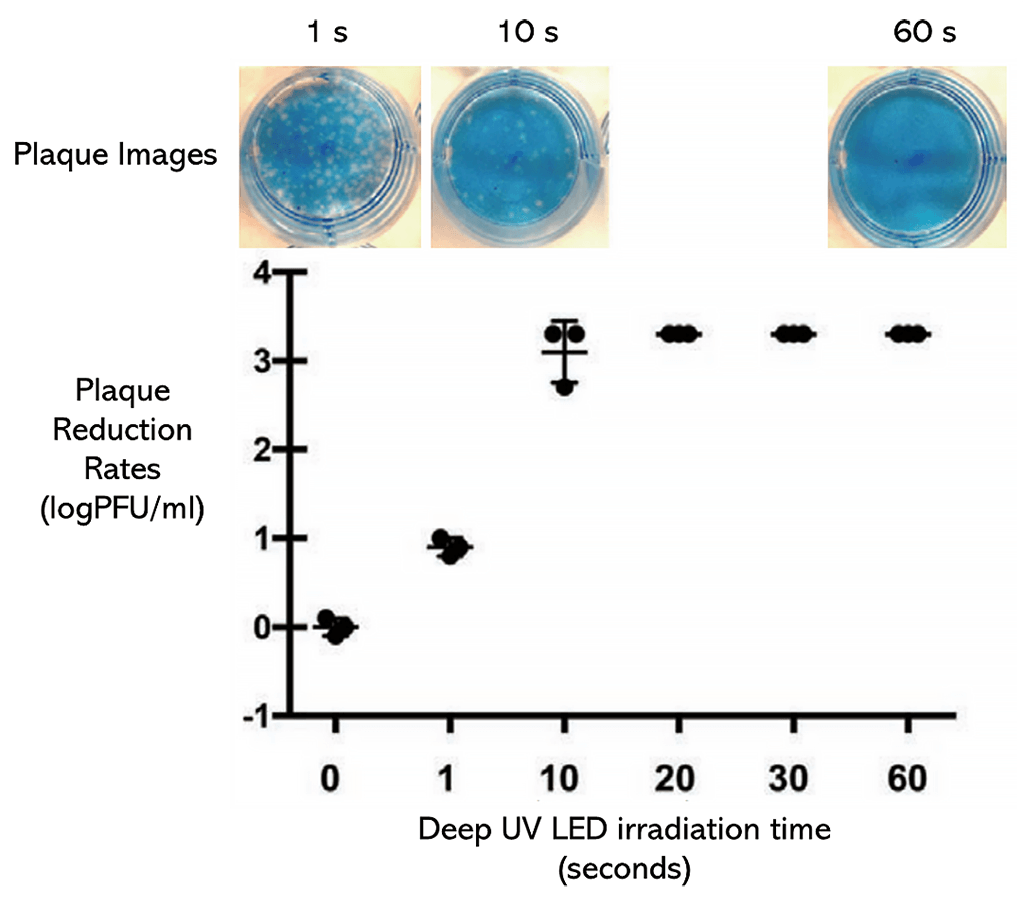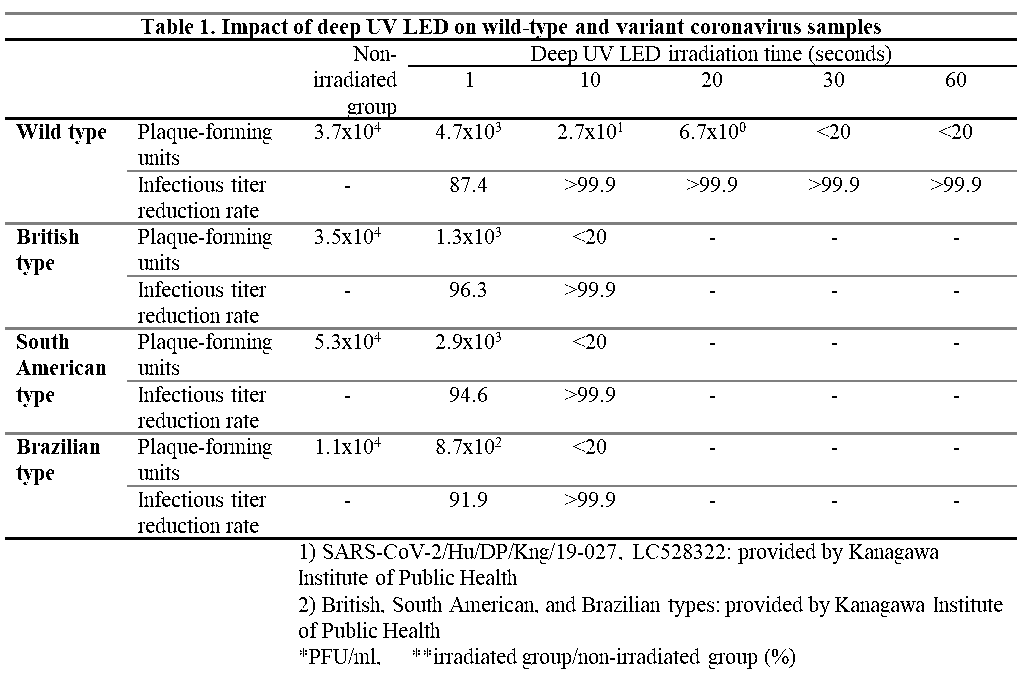The novel coronavirus is considered to have spread to humans from animals. Mutant variants have also emerged, and it is unclear how long the virus will remain a threat. Although vaccines are expected to be effective, measures taken against the spread of infection remain indispensable. Therefore, research was focused on deep ultraviolet (UV) rays that are used for sterilization in the healthcare setting. A University of Miyazaki group discovered that the novel coronavirus and its mutant strains can be effectively inactivated by using light-emitting diodes (LED), a new popular light source, to deliver UV radiation. This article presents the results of a study on the novel coronavirus, which was conducted under the University of Miyazaki's "One Health" concept that aims to break barriers between human and veterinary medicine and academia and industry.
Background
The novel coronavirus pandemic has proven that globalization in recent years has greatly affected the spread of infectious diseases. The importance of disinfection has been recognized, and the restriction of movement of humans and animals is deemed crucial to avoid the spread of infectious diseases. In 2000 and 2010, residents of Miyazaki suffered from hand-foot-and-mouth disease, a viral infectious disease that is devastating for cattle and pigs. At that time, the residents realized that thorough disinfection measures to reduce viral transmission and restriction of the movement of people and things are important to ensure early containment of the spread of infectious diseases.
As a result of these experiences, the establishment of an epidemic prevention system at the University of Miyazaki was considered necessary, and in October 2011, the Center for Animal Disease Control (CADIC) was established as an intra-academic cooperative education research facility. The facility has improved its functions as an infectious disease research center, and an advanced pathogen containment facility that operates at biosafety level 3 (BSL3) has been established. Since the University of Miyazaki's Graduate School of Medicine and Veterinary Medicine is the only institution in Japan where collaboration between researchers of human and veterinary medicine exists, the CADIC is an educational facility that targets not only infectious diseases in livestock but also zoonotic diseases. It also acts as a research facility, and research originating from this institution has clarified new infection cycles such as those of severe fever with thrombocytopenia syndrome virus, which is a cause of lethal viral infections in humans and animals. In November 2019, the Faculty of Medicine launched the joint research course M&N Collaboration Research Laboratory, Department of Medical Environment Innovation, which aims to tackle innovation in the medical field, based on a joint research comprehensive collaboration agreement (concluded in November 2016) between Nikkiso Co., Ltd. (headquartered in Shibuya, Tokyo) and the University of Miyazaki that aimed to establish a joint research promotion system between the two organizations. To solve the problems encountered in the field of medicine, the institution is conducting comprehensive joint research using the industry-academia cooperation system and have quickly made progress in their research.
The novel coronavirus pandemic, the first case of which was reported in China in December 2019, completely changed our lifestyle. This resulted in shortages of materials such as masks, gloves, protective clothing, and antiseptics for prompt infection control. To respond to this unusual situation, CADIC in cooperation with the Department of Veterinary Sciences introduced a new coronavirus acquisition and diagnostic system in March 2020 and deployed a research system. In addition to this, in the Medical Environment Innovation Course, the researchers focused on UV rays, which are highly effective in controlling infections. Among them, deep UV rays have a strong bactericidal effect as they are capable of delivering a high degree of UV radiation in a short time. The research group worked to apply these technologies in the medical field. At Nikkiso Co., Ltd., the problem of reduced light output that UV rays encounter as the wavelength becomes shorter was overcome by introducing the blue LED technology that won the 2014 Nobel Prize in Physics.
Researchers at the University of Miyazaki immediately confirmed the inactivating effect of the deep UV LED on the novel coronavirus. Utilization of this technology as a measure against the transmission of the novel coronavirus for the benefit of society is important not only in medical institutions but also in general life. Therefore, joint research was conducted at the University of Miyazaki utilizing the "One Health" concept, which is a cross-disciplinary collaboration between human and veterinary medicine.
Novel Coronavirus Inactivation Effect via Deep UV LED Irradiation
Experiments testing the inactivating effect of deep UV LEDs on the novel coronavirus were conducted using the following strains: wild-type novel coronavirus isolated in Japan (SARS- CoV-2/Hu/DP/Kng/19-027, LC528233, provided by Kanagawa Institute of Public Health), and the following mutant viral strains (UK type: hCoV-19/Japan/QHN001/2020 [B.1.1.7], South African type: hCoV-19/Japan/TY8-612/2021 [B.1.351], Brazilian type: hCoV-19/Japan/TY7-501/2020 [P.1], all provided by the National Institute of Infectious Diseases) Various viral solutions were adjusted to a concentration of 2.0 × 104 plaque-forming units (PFU)/ml, and 15 μl was added dropwise onto a plastic petri dish. The dropped viral solution was irradiated with a deep UV LED for 1, 10, 20, 30, and 60 seconds using an output of 3.75 mW/cm2 from a distance of 2 cm (however, the mutant virus was irradiated for 1 and 10 seconds). The cells were infected with each irradiated viral solution, and PFU/ml was measured 72 hours after the infection. The effect of deep UV LED irradiation on viral infectivity titers was assessed by comparing PFU/ml between the irradiated and non-irradiated viral solutions. VeroE6/TMPRSS2 cells were used for viral culture and plaque-forming studies. These tests were conducted in the BSL3 laboratory at the CADIC.

The virus used was SARS-CoV-2/ Hu/DP/Kng/19-027 (LC528233, provided by Kanagawa Institute of Public Health).
Fig. 1 shows the plaque formation state and the number of plaques in the cells infected with viral solutions irradiated for 1 and 60 seconds and with a non-irradiated viral solution (Fig. 1 is an experimental image of a Japanese isolate). One can see that the white holes indicative of virus infection (i.e., the number of plaques) decreased with increased time of irradiation using the deep UV LED. The percentage reduction in the number of plaques under various conditions is shown in Table 1. The viral infectivity was suppressed by more than 99.9% with 10-second deep UV LED irradiation and 87.4-96.3% with 1-second deep UV LED irradiation. These results show that deep UV LED irradiation inactivates mutant types (British type, South African type, Brazilian type) in a short time in addition to the wild-type coronavirus.

Future Policies and Challenges
The researchers at the University of Miyazaki applied the "One Health" concept that aims to break barriers between human and veterinary medicine and academia and industry. As a result, they succeeded in demonstrating the effectiveness of deep UV LED irradiation in inactivating the novel coronavirus, which is now a global problem. Among the UV rays used for controlling the spread of infections, deep UV rays were selected because they exert the pathogen inactivation effect in a short period of time. For practical use, this feature of deep UV rays was combined with the features of LEDs owing to their small size and durability, which made efficient use of deep UV LED possible. Furthermore, the use of deep UV LED can be expected not only in the medical field but also in daily life in accordance with the "New Lifestyle" guidelines put out by the Ministry of Health, Labor and Welfare because they are effective against infectious diseases.
It has been indicated that airborne transmission of the novel coronavirus is possible in addition to its transmission via droplets and direct contact. Regardless of the mode of infection, it is important to improve indoor air circulation to decrease the risk of infection in sealed indoor and poorly ventilated conditions. This deep UV LED irradiation can be expected to be used in such air circulation systems bebecause of its instantaneous virus-inactivating effect. In addition, although it has been pointed out that long-term exposure to UV irradiation is associated with problems such as plastic deterioration, deep UV LED irradiation, which was confirmed to have a virus-inactivating effect with short-term irradiation, can be applied to prevent this from occurring and reduce the risk of contact transmission.
In this study, the virus-deactivating effect of deep UV LED irradiation was confirmed against the novel coronavirus probably because it is enclosed by a membrane composed of a lipid bilayer called the envelope. The envelope plays an important role in viral infection since it enables fusion of the virus with the cell, and becomes an important target for preventing viral infection. It is also the reason for the efficacy of alcohol disinfectants and surfactants in preventing viral transmission. However, nonenveloped viruses (e.g., noroviruses) are not affected by these antiseptic agents. Bacteria and fungi have biological structural forms that are different from those of viruses. While the efficacy of disinfectants and antimicrobials has been confirmed against bacterial and fungal infections, the number of effective disinfectants is limited, and the emergence of drug-resistant bacteria has become a global challenge. The inactivation effect of deep UV LED irradiation not only on the novel coronavirus but also on non-enveloped viruses, bacteria, and fungi has been verified, and its application in other effective infectious disease control measures is being considered.
Conclusions
Through this initiative, the research group at the University of Miyazaki was the first in the world to announce that deep UV LED irradiation is effective as an infection control measure against the novel coronavirus, which has become a global issue. Researchers at the University of Miyazaki employed the "One Health" concept to promote cross-disciplinary education and research by establishing the CADIC and human and veterinary medicine collaboration to address the urgent issue of transmission of infection diseases at the human-animal-environment interface. This is the result of the organic functioning of the "industry-academia collaboration system" that promotes comprehensive joint research between Nikkiso Co., Ltd. and the University of Miyazaki.
(Collaborators: M&N Collaboration Research Laboratory, Department of Medical Environment Innovation, Faculty of Medicine, University of Miyazaki: Special Assistant Professor Hironobu Sugiyama, Assistant Professor Hiroko Inagaki; Department of Hemovascular Medicine and Artificial Organs, Faculty of Medicine, University of Miyazaki: Shouichi Fujimoto; Veterinary Microbiology Laboratory, Department of Veterinary Sciences, Faculty of Agriculture, University of Miyazaki: Associate Professor Akatsuki Saito; Miyazaki University Industrial Animal Epidemic Prevention Research Center, Department of Veterinary Sciences, Faculty of Agriculture, University of Miyazaki: Assistant Professor Chiho Kaneko)

Tamaki Okabayashi
Miyazaki University Industrial Animal Epidemic Prevention Research Center, Veterinary Microbiology Laboratory, Department of Veterinary Sciences, Faculty of Agriculture, University of Miyazaki




